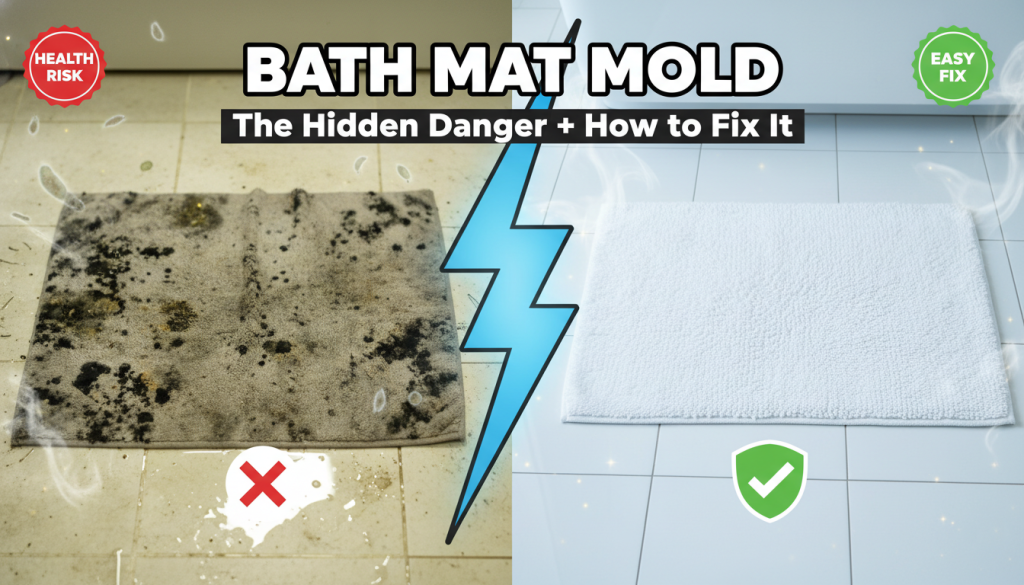
I’ll be honest with you—I never thought much about my bath mat until the day I lifted it up and discovered a nightmare of black spots underneath. That moment changed everything. What I’d assumed was just a harmless piece of bathroom decor turned out to be a breeding ground for things I really didn’t want to think about.
If you’ve ever wondered whether your bath mat is actually clean, or if that musty smell means something more serious is going on, you’re in the right place. After dealing with my own mold disaster and testing various materials and cleaning methods, I’ve learned more about bath mat hygiene than I ever expected to know. Let me share what actually works.
Understanding the Hygiene Reality of Bath Mats
Are Bath Mats Sanitary? The Honest Answer
Here’s the truth nobody wants to hear: most bath mats are far less sanitary than we’d like to believe. I learned this the hard way when I realized my “clean” bathroom had a mat that was anything but.
Think about what your bath mat deals with every single day. You step on it with wet feet right after showering. Water drips onto it constantly. It sits in one of the warmest, most humid rooms in your house. And unless you’re washing it every few days (which, let’s be real, most of us aren’t), it’s basically a welcome mat for microorganisms.
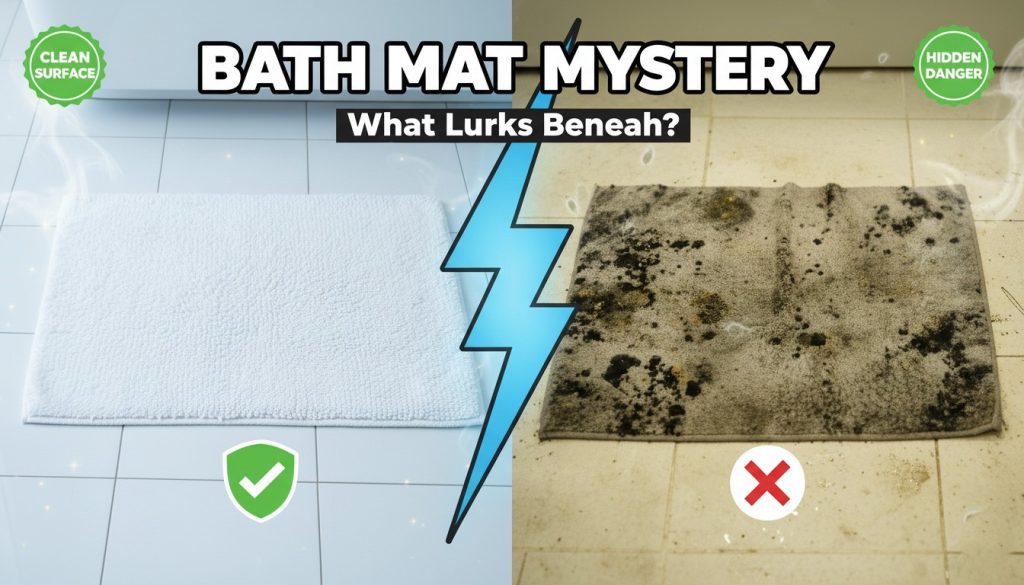
The bathroom environment creates perfect conditions for bacterial and fungal growth. Temperatures hover between 70-80°F, humidity spikes after every shower, and there’s a constant supply of moisture and dead skin cells. Studies have actually found that bathroom textiles can harbor bacteria levels comparable to kitchen sponges. That’s not a comparison anyone wants to hear.
But here’s the thing—bath mats don’t have to be gross. With the right approach, they can be reasonably hygienic. The key is understanding what you’re dealing with and being realistic about maintenance.
The Mold Question: Do Bath Mats Get Moldy?
Yes. Absolutely, unequivocally yes. If someone tells you their bath mat has never gotten moldy, they either wash it religiously or they haven’t looked underneath recently.
I first noticed mold on my favorite cotton bath mat after about three months of regular use. At first, it was just a faint musty smell. Then I spotted some discoloration along the edges. When I finally flipped it over, I found dark patches that made my stomach turn. Mold had been growing there for who knows how long.
Mold develops fast in bathroom conditions. In my experience, if a wet bath mat sits on tile or linoleum without proper drying, visible mold can appear in as little as 24-48 hours. Even if you don’t see it on the surface, check the underside and the floor beneath it. That’s where the real horror show usually happens.
The visual signs aren’t always obvious at first. You might see slight discoloration—maybe some pinkish or black speckling. Sometimes the mat feels slimy or develops a rough texture where it used to be soft. But often, the smell is your first warning sign.
Bacterial Concerns You Should Know About
Beyond mold, bacteria is the other elephant in the bathroom. Every time you step on your mat with freshly washed feet, you’re actually transferring bacteria back onto them. It’s a vicious cycle that made me rethink my entire post-shower routine.
Common bacteria found on bath mats include Staphylococcus (which can cause skin infections), E. coli (yes, really), and various fungi that cause athlete’s foot. If anyone in your household has compromised immunity, open cuts, or existing skin conditions, a dirty bath mat poses genuine health risks.
I noticed this firsthand when my partner kept getting recurring athlete’s foot despite treatment. We finally realized the bath mat was reinfecting him every single day. Once we started washing it more frequently and switched to a quick-drying material, the problem cleared up within weeks.
Why Bath Mat Smell Issues Develop (And What They Mean)
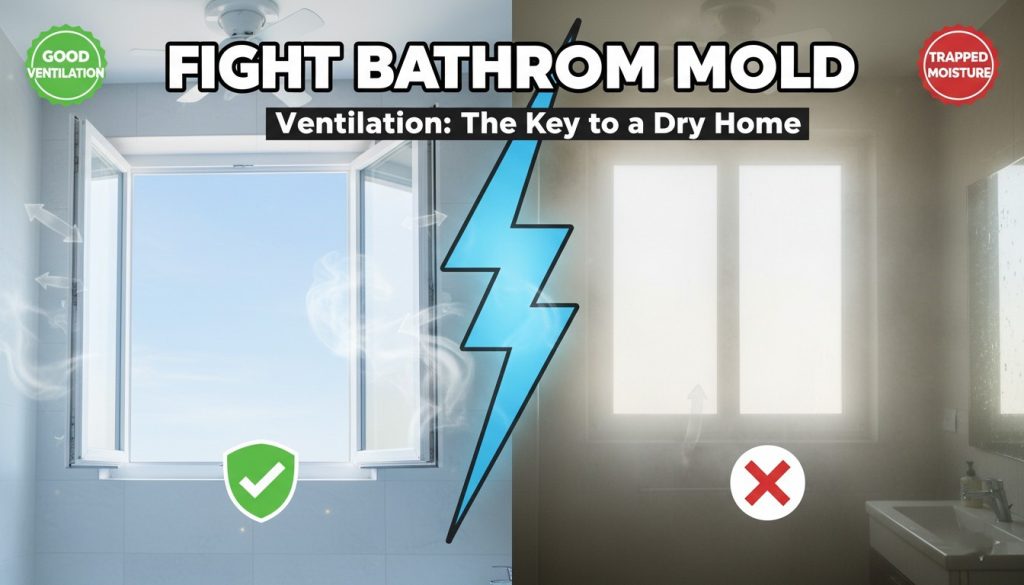
The Science Behind Musty Odors
That distinctive musty, mildew-y smell is your bath mat screaming for help. I used to think it just meant the mat needed washing, but it actually indicates active microbial growth.
The odor comes from volatile organic compounds released by mold and mildew as they consume the organic matter in your mat. Bacteria produces its own distinctive smells—sometimes sour, sometimes just “off.” If your mat smells bad even when it looks clean, something is growing in the fibers or on the underside.
I’ve found that certain materials are way more prone to developing odors than others. My thick, plush microfiber mat constantly smelled musty because it took forever to dry. Meanwhile, a thinner cotton option dried faster and stayed fresher longer—even though I washed them on the same schedule.
Warning Signs Your Mat Has a Problem
Your nose is usually your best early warning system. If you walk into your bathroom and detect any musty, sour, or mildew smell, investigate immediately. Don’t wait for visible mold to appear.
Other signs I’ve learned to watch for include the mat feeling damp hours after anyone has showered, any color changes (especially darkening or yellowing), and changes in texture. One of my bamboo mats started feeling slightly slimy between the slats before I saw any actual mold—that tactile warning gave me time to deep clean before things got worse.
If you press the mat and water squeezes out, even if it’s been several hours since anyone showered, that’s a red flag. Mats should dry relatively quickly. Persistent dampness means trouble.
Material-Specific Mold and Maintenance Guide
Mold on Stone Bath Mats
Stone bath mats—especially those made from diatomaceous earth—are marketed as the holy grail of mold resistance. I was so excited when I bought mine, convinced I’d never deal with mold issues again. Reality check: that’s not entirely true.
The stone surface itself does dry incredibly fast, which is genuinely impressive. Water evaporates almost immediately after you step off. But mold can still grow in the grout lines between stone pieces, on the rubber or cork backing underneath, and especially on the floor beneath the mat if you never move it.
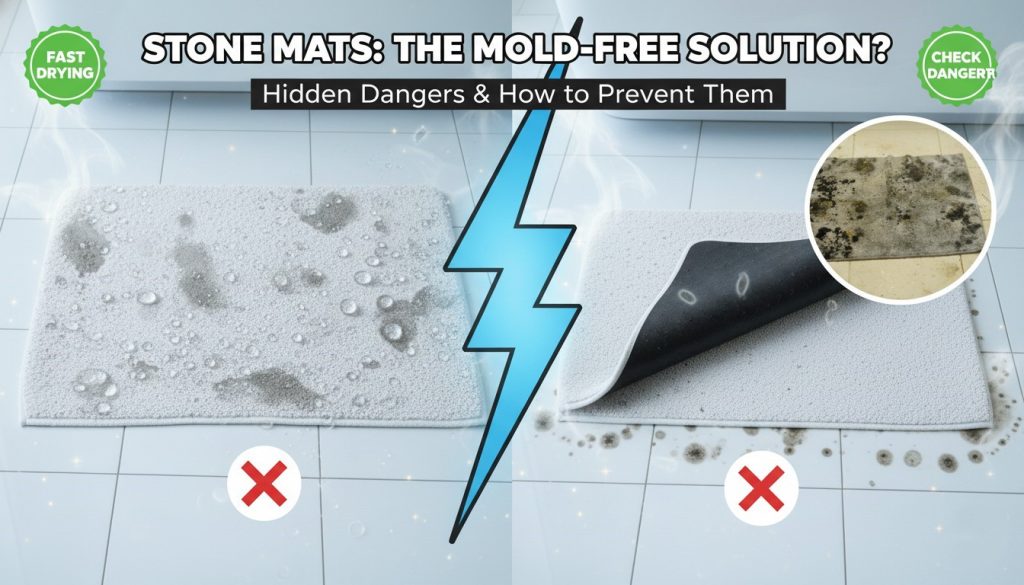
I discovered this after six months of never lifting my stone mat. The stone top was pristine, but when I finally picked it up, there were mold spots on both the rubber backing and the tile floor underneath. Lesson learned: even “mold-resistant” doesn’t mean mold-proof.
To maintain stone mats properly, I now rinse mine weekly with water and a mild soap, making sure to clean the backing and edges. I also prop it up against the wall once a week to let both sides air out completely. It sounds like overkill, but it’s the only way to truly prevent mold growth.
Wooden Bath Mat Maintenance
Wooden bath mats look gorgeous—that spa-like aesthetic is undeniably appealing. But wood and constant moisture are not natural friends, and I learned this through multiple failed attempts at keeping a wooden mat pristine.
Wood is porous and absorbent, which means it soaks up water and holds onto moisture. Even treated or sealed wood will eventually develop problems if you don’t maintain it obsessively. My first wooden mat developed mold within two months, concentrated in the areas where water pooled between the slats.
The key with wooden mats is aggressive drying. After every single shower, I now hang mine over the tub edge or lean it vertically against the wall. Just leaving it flat on the floor is asking for trouble. I also take it outside for sun exposure at least once a month—UV light naturally kills mold and helps dry out the wood completely.
If you’re committed to a wooden mat, choose teak or bamboo varieties that have natural water-resistant properties, and make sure it’s been properly sealed. Check the sealant every six months and reapply as needed. It’s high maintenance, but it can work if you’re diligent.
Bamboo Bath Mat Care
Bamboo occupies an interesting middle ground. It’s naturally more moisture-resistant than regular wood and has some antimicrobial properties. Marketing materials make it sound like a miracle material, but I’ve found those claims need heavy asterisks.
Yes, bamboo resists mold better than pine or cedar would. But it’s not immune. The antimicrobial properties are real but limited—they slow bacterial growth, they don’t prevent it entirely. My bamboo mat still developed mildew in the joints and on the fabric strips that hold the slats together.
The specific construction matters enormously. Rolled bamboo mats with fabric backing are particularly problematic because water gets trapped in that fabric. Slatted bamboo mats with gaps for airflow perform much better. I switched from a rolled style to a slatted design and saw immediate improvement.
For cleaning bamboo, I wipe it down weekly with a vinegar-water solution (about 1:4 ratio), making sure to get between all the slats. Every few weeks, I give it a more thorough scrub with a soft brush. The natural antimicrobial properties help, but you still need to do your part.
The Truth About Moss Bath Mats
Moss bath mats are one of the trendiest bathroom items I’ve tried, and also one of the most controversial. The concept is fascinating—live moss that supposedly thrives on the moisture from your feet and naturally resists mold.
The reality? It’s complicated. I tried a moss mat for about three months before giving up. The moss itself didn’t really mold (it’s a living plant, after all), but the foam base it grows on definitely did. Plus, the moss required more maintenance than advertised—it needed regular misting, indirect light, and periodic “feeding” with the moisture from showers.
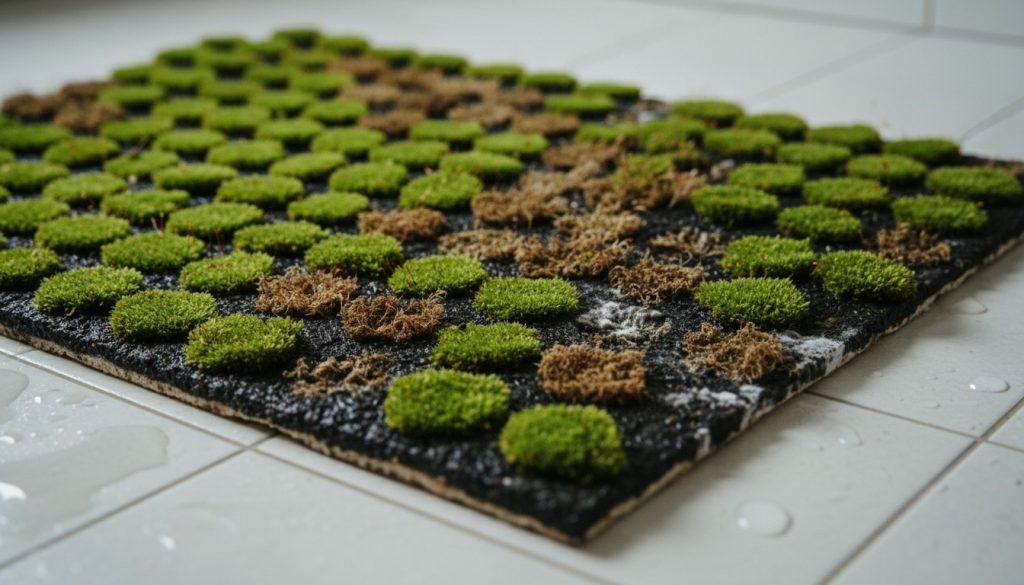
The bigger issue is that moss mats aren’t truly low-maintenance like the marketing suggests. If your bathroom doesn’t get enough natural light, the moss dies and turns brown. If it gets too wet too often, it gets waterlogged and starts to smell. Finding the perfect balance felt like having a pet that lived on my bathroom floor.
I also worried about mold on the substrate beneath the moss. Even though the moss was alive and green, I couldn’t see what was happening underneath. When I finally dismantled it (the moss had mostly died), I found moisture damage and early mold growth in the foam base.
How to Prevent Mold and Mildew: Proven Strategies
Daily Habits That Make a Difference
The single most effective thing I do to prevent mold is so simple it almost feels silly: I hang up my bath mat after every shower. Not later in the day. Not when I remember. Every. Single. Time.
I installed a towel bar on the back of my bathroom door specifically for this purpose. After showering, the mat goes directly onto that bar, draped so both sides get air exposure. This one habit has prevented more mold than any cleaning product I’ve ever used.
Bathroom ventilation is the other non-negotiable. I turn on the exhaust fan before I start the shower and leave it running for at least 30 minutes after I’m done. If your bathroom has a window, crack it open during and after showers. Moving air is mold’s enemy.
If you have multiple people showering daily, consider rotating between two mats. While one dries thoroughly (which takes 24 hours minimum for most materials), use the other. This prevents the constant dampness that leads to mold growth.
Weekly Maintenance Routine
Every week, without fail, my bath mat goes in the washing machine. I used to wash it every two weeks, thinking that was sufficient. It wasn’t. Weekly washing makes a massive difference in preventing odor and mold buildup.
I wash cotton and microfiber mats in hot water with regular detergent plus a half-cup of white vinegar. The vinegar helps kill any mold spores and eliminate odors without damaging the fibers. For colored mats, I use warm water instead of hot to prevent fading, but I make sure it’s at least 140°F—anything cooler won’t effectively kill microorganisms.
After washing, I dry mats on high heat if the care label allows it. The heat from the dryer kills any remaining spores and ensures the mat is completely dry before it goes back on the floor. If the mat can’t go in the dryer, I hang it outside in direct sunlight, which provides natural UV disinfection.
For non-washable mats like stone, wood, or bamboo, my weekly routine involves a thorough wipe-down with diluted vinegar or tea tree oil solution, followed by complete air drying—preferably in sunlight if possible.
Deep Cleaning Methods
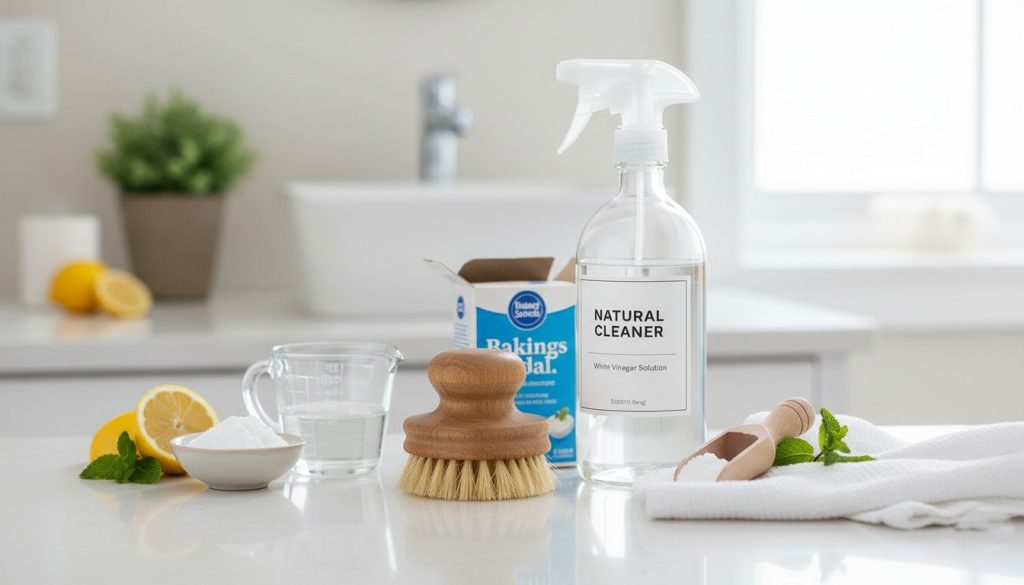
Once a month, I do a deep clean that goes beyond the regular wash cycle. This is especially important if I’ve noticed any musty smells or if the mat seems less fresh than it should be.
My go-to method for washable mats involves a pre-soak in a bathtub with hot water, a cup of baking soda, and a cup of white vinegar. I let it soak for at least an hour, sometimes overnight if it smells particularly bad. The baking soda and vinegar combination lifts embedded dirt and kills mold spores remarkably well.
After soaking, I scrub any visible stains or discolored areas with a brush before running the mat through a hot wash cycle. Sometimes I run it through twice if it was especially dirty—once with detergent, once with just vinegar for a final disinfecting rinse.
For heavily molded mats, bleach is sometimes necessary, but I use it sparingly and only on white cotton mats. The ratio I use is a quarter-cup of bleach per gallon of water. I never mix bleach with vinegar (this creates toxic chlorine gas), and I always make sure the mat is thoroughly rinsed afterward.
Stone and wooden mats need different deep cleaning approaches. For these, I use a paste of baking soda and water, scrub gently with a soft brush, rinse thoroughly, and then sanitize with diluted tea tree oil (10-15 drops per cup of water). Tea tree oil is a natural antifungal that won’t damage these materials like harsh chemicals might.
Environmental Controls
Controlling your bathroom’s environment might be the most important factor of all. I installed a hygrometer (a device that measures humidity) in my bathroom, and it was eye-opening to see humidity levels spike to 80-90% during and after showers.
Ideally, bathroom humidity should stay below 50% to prevent mold growth. That’s nearly impossible during a shower, but you want it to drop back down quickly afterward. A good exhaust fan is essential—mine moves at least 50 cubic feet per minute (CFM), which is the minimum recommended for most bathrooms.
If your bathroom doesn’t have an exhaust fan or window, consider a small dehumidifier. I use one in my windowless guest bathroom, and it keeps the humidity in check remarkably well. Just make sure to empty it regularly.
Temperature also matters. Mold loves warmth, so keeping your bathroom cooler helps (though obviously you can’t control this during a hot shower). But I’ve found that even just ensuring good airflow—by keeping the bathroom door open when it’s not in use—helps regulate both temperature and humidity.
The bathroom layout itself can impact mat hygiene. I learned not to place my mat directly against the wall or in a corner where air can’t circulate around it. Mats need breathing room on all sides to dry properly.
Material Selection for Maximum Hygiene
Most Hygienic Bath Mat Materials
After testing probably a dozen different bath mats over the past few years, I’ve developed strong opinions about which materials are genuinely hygienic versus which just pretend to be.
Quick-drying synthetic materials win for pure hygiene. My current favorite is a thin microfiber mat with a perforated design that allows airflow through the material. It dries within a couple of hours, goes in the washing machine without any special care, and has stayed mold-free for over a year with just weekly washing.
Cotton is classic for good reason—it’s absorbent, machine washable, and durable. But not all cotton mats are equal. Thin cotton with a low pile dries much faster than those plush, luxurious hotel-style mats. I’ve had better luck with waffle-weave or textured cotton that has built-in drainage rather than solid, thick terry cloth.
Some mats come with antimicrobial treatments infused into the fibers. I was skeptical at first, but I’ve actually noticed a difference. My antimicrobial-treated mat stays fresher longer between washes and has never developed that musty smell that untreated mats get. Just know that these treatments can wash out over time, so they’re not permanent solutions.
Memory foam mats with quick-dry covers have also performed well for me. The foam core stays dry because the moisture-wicking cover pulls water away, and the whole thing can go in the washing machine. Just make sure the cover is removable and washable—non-removable covers defeat the purpose.
Materials to Approach with Caution
I want to love thick, plush bath mats. They feel amazing underfoot. But they’re hygiene nightmares. The dense pile holds moisture for hours, creating ideal conditions for mold and bacteria. If you must have that plush feeling, at least choose one with antimicrobial treatment and commit to washing it twice weekly.
Natural fiber mats like jute or cotton shag rugs are beautiful but problematic. They absorb water readily but dry incredibly slowly. I tried a gorgeous jute mat that developed mold within three weeks despite my best efforts. It ended up in the trash, which felt wasteful and frustrating.
Rubber-backed mats seem practical—the rubber keeps them from sliding around. But that rubber backing traps moisture between the mat and the floor, creating a sealed environment where mold thrives. I’ve had better experiences with mats that have perforated or mesh backing that allows some airflow.
Bath mats with decorative elements like sequins, beading, or heavy embroidery are difficult to clean thoroughly. Water and bacteria hide in and around these embellishments. They also can’t usually go in the washing machine, limiting your cleaning options to spot cleaning and hoping for the best.
When to Replace Your Bath Mat
Red Flags That Signal Replacement
There comes a point when even the best cleaning efforts can’t save a bath mat. I’ve learned to recognize when I’m fighting a losing battle and it’s time to just start fresh.
Persistent odors that survive multiple hot washes with vinegar and baking soda are the clearest sign. If a mat still smells musty even right after washing and drying, mold has penetrated too deeply into the fibers or backing. I’ve tried everything to save mats like this, and it’s never worth the effort.
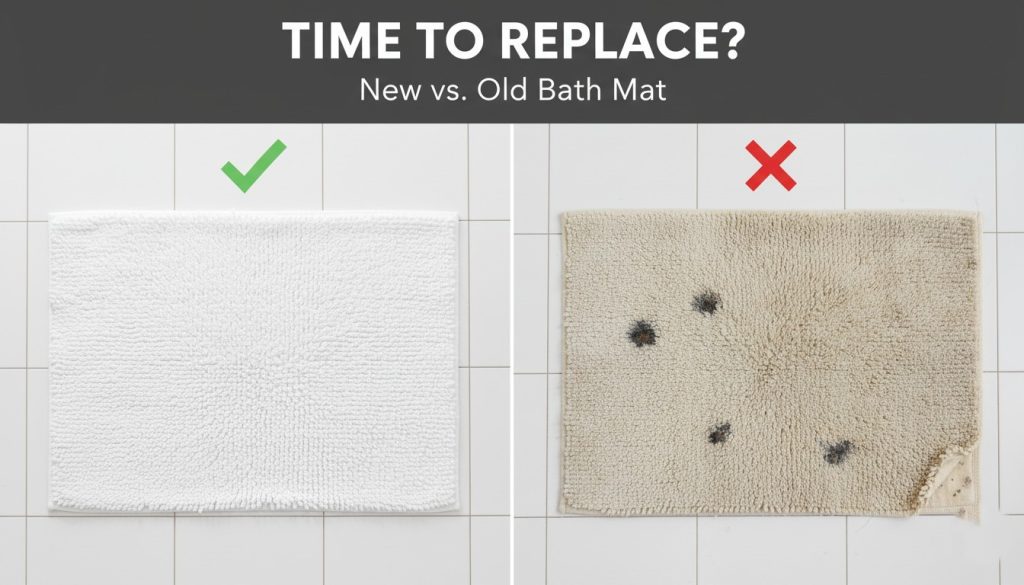
Visible mold that won’t come out is another obvious signal. Sometimes you can bleach out surface mold, but if dark spots remain after aggressive cleaning, those spores are embedded for good. I once spent two hours trying to rescue a favorite mat with stubborn mold stains. Looking back, I should have thrown it out after the first hour.
Material degradation means it’s time to replace. When the backing starts peeling or crumbling, when fibers become matted and worn, or when the mat loses its shape and lies unevenly on the floor, its useful life is over. A degraded mat is not only unhygienic—it’s also a tripping hazard.
If the mat has developed any kind of slimy texture that won’t wash out, don’t even bother trying to save it. That slime is a biofilm of bacteria and mold, and it indicates deep contamination. Into the trash it goes.
Expected Lifespan by Material Type
Understanding how long different materials typically last has helped me set realistic expectations and budget accordingly.
Cotton and microfiber mats generally last me one to two years with weekly washing. The better the initial quality, the longer they last—a cheap cotton mat might only make it six months before falling apart, while a well-made one can push two years. I usually start noticing deterioration around the 18-month mark.
Bamboo and wooden mats can last two to three years if you take excellent care of them. My first bamboo mat died after eight months because I didn’t maintain it properly. My current one is approaching two years and still looks great because I’m religious about drying it after every use and treating it monthly with wood oil.
Stone and synthetic mats have the longest lifespan at three to five years. My diatomaceous earth mat is three years old and still functionally perfect. The stone surface is virtually indestructible, though the backing might need replacement eventually. High-quality synthetic mats are similarly durable—they just eventually get dingy or the backing wears out.
It’s worth noting that these lifespans assume proper maintenance. Neglect can cut the lifespan in half or more. Conversely, if you’re exceptionally diligent with care, you might squeeze a bit more time out of each mat.
Frequently Asked Questions
Can you completely eliminate mold risk?
Honestly? No. Unless you live in a climate-controlled cleanroom, you can’t eliminate all mold risk. Mold spores are everywhere in the environment. But you can reduce the risk to minimal levels where it’s not a practical concern. With proper maintenance—daily drying, weekly washing, good ventilation—I’ve kept mats mold-free for over a year. That’s pretty close to elimination in real-world terms.
How often should you wash different mat types?
For machine-washable cotton and microfiber mats, weekly washing is ideal, every two weeks at the absolute minimum. If multiple people use the bathroom daily, lean toward twice weekly. For non-washable mats like stone or wood, wipe them down weekly and do a more thorough clean monthly. If anyone in your household has immune issues or foot infections, increase washing frequency to twice weekly regardless of material.
Are antimicrobial mats worth the investment?
In my experience, yes—with caveats. Antimicrobial-treated mats do stay fresher longer and resist odor development better than untreated versions. But they’re not magic. You still need to wash them regularly and practice good bathroom hygiene. They’re worth the extra cost if you’re already committed to proper maintenance. If you’re hoping they’ll let you skip washing, you’ll be disappointed.
What’s the most low-maintenance option?
Stone mats, particularly diatomaceous earth, are the lowest maintenance in my experience. They dry in minutes, require only weekly wipe-downs, and last for years. The initial cost is higher, but the time and effort saved over the mat’s lifespan makes it worthwhile. If stone isn’t your aesthetic, thin microfiber mats are the next best option—they dry quickly and handle frequent machine washing without degrading.
Can moldy mats make you sick?
Yes, they can, though the risk varies. For most healthy adults, exposure to bath mat mold might cause minor issues like skin irritation or allergic reactions. But for people with asthma, mold allergies, or compromised immune systems, it can trigger more serious respiratory problems. I developed a persistent cough once that cleared up only after I threw out a seriously moldy mat I’d been ignoring. Even if it doesn’t make you actively sick, it’s not doing your health any favors.
Conclusion
I never expected to become someone who thinks this much about bath mats, but here we are. The truth is, these seemingly simple bathroom accessories have a much bigger impact on hygiene and health than most of us realize.
The good news is that maintaining a clean, mold-free bath mat isn’t actually that complicated. It comes down to three core principles: choose materials that dry quickly, create an environment where mold struggles to grow, and stay consistent with cleaning. You don’t need expensive products or hours of effort—just some basic habits that become second nature over time.
My biggest takeaway from years of trial and error is this: prevention is infinitely easier than remediation. The few minutes it takes to hang your mat after each shower, the 30 seconds to start the exhaust fan, the weekly trip to the washing machine—these small actions prevent the much bigger hassle of dealing with established mold or having to replace mats prematurely.
Start with one new habit today. If you do nothing else, hang your mat up to dry after your next shower. That single change will make more difference than you’d expect. Your feet (and your nose) will thank you.
Leave a Reply